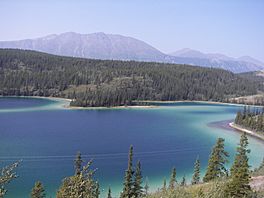Emerald Lake (Yukon) facts for kids
Quick facts for kids Emerald Lake |
|
|---|---|
 |
|
| Location | Yukon Territory, Canada |
| Coordinates | 60°15′58.8″N 134°45′02.6″W / 60.266333°N 134.750722°W |
Emerald Lake is a beautiful lake located in the southern Yukon territory of Canada. It's famous for its amazing, bright green color! You can find it along the South Klondike Highway. The lake gets its special green look from sunlight bouncing off tiny white bits of marl at the bottom. Marl is a mix of clay and a mineral called calcium carbonate.
Contents
Why is Emerald Lake Green?
The stunning green color of Emerald Lake comes from something called marl. Marl is a soft, white material found at the bottom of the lake. It's made up of tiny pieces of clay mixed with calcium carbonate.
How Calcium Carbonate Colors the Lake
Think of calcium carbonate like a very fine, white powder. When sunlight hits this powder at the bottom of the shallow lake, it reflects a bright, emerald green color back to your eyes. This is similar to how a clear blue sky looks blue because of how sunlight scatters off tiny particles in the air.
How Emerald Lake Was Formed
Emerald Lake was created a very long time ago, about 14,000 years back. This was during the last ice age.
The Power of Glaciers
Giant sheets of ice, called glaciers, moved slowly across the land. As they moved, these glaciers were incredibly powerful. They carved out the shallow bowl where the lake now sits. This process is called glacial erosion.
Limestone and Lake Formation
The glaciers also picked up and carried pieces of limestone from nearby mountains. Limestone is a type of rock rich in calcium carbonate. When the glaciers melted, they left behind these limestone pieces. Over time, the limestone broke down, releasing lots of calcium carbonate into the lake water. This is why the lake has such a high amount of calcium carbonate, which helps create its famous green color.
See also
In Spanish: Lago Esmeralda (Yukón) para niños



